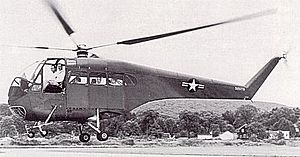- Doman LZ-5
-
LZ-5 Role Utility helicopter Manufacturer Doman Helicopters Designer Glidden Doman First flight 27 April 1953 Status Prototypes only Number built 3 The Doman LZ-5 was a utility helicopter developed in the United States in the early 1950s by Doman Helicopters Inc. of Danbury, Connecticut. Despite the procurement of international manufacturing agreements, no series production of the aircraft ever occurred and only three prototypes were built. Two of these were purchased by the United States Army as the YH-31, but eventually becoming VH-31.[1]
Development
Like the preceding LZ-1 through LZ-4, the LZ-5 utilized designer Glidden Doman's unorthodox gimbaled rotor head system, which featured the elimination of rotor hinges and dampers and included blades of soft-in-plane dynamic design. The servo control system was entirely contained within the rotor head, with no external oil tanks or plumbing. The tail rotor was also hingeless and free floating to eliminate stresses in rapid tail rotor turns. In other ways it had a conventional helicopter main rotor and tail rotor configuration. The pilot and co-pilot were seated over the engine, which was in the nose, and a six-passenger compartment was located behind them. The engine was cooled by exhaust ejectors, producing an energy saving that increased payload by 800 pounds. The aircraft featured wheeled quadricycle undercarriage, the main units of which carried dual wheels.[citation needed]
The first prototype (registration N13458) flew on 27 April 1953, and by the end of 1955, two machines had been delivered to the Army (52-5779 and 52-5780). Eventually, the Army concluded that they had no requirement for an additional piston-powered helicopter model in this size category, and no further order was placed. After extensive flight testing and pilot training by the Army, one of the prototypes was taken over by the Navy for a helicopter flight research program at the Patuxent River Naval Air Test Center. Later that aircraft was re-purchased by the Doman company and used in its commercial sales efforts.[citation needed]
Doman continued with development, building another LZ-5 aircraft in a joint venture with Fleet in Canada. The LZ-5 helicopters were simultaneously Type Certificated in U.S. and Canada in 1954. The third helicopter flew extensively in Canada under Canadian registration CF-IBG and in the United States, France, and Italy under U.S. registration N812. It flew in the Paris Air Show in 1960. This aircraft was also modified with the installation of full blind flight instrumentation, which was demonstrated extensively in the effort to sell it as a trainer. The aircraft thus equipped was advertised as the D-10. The planned production version would have been modified with a turbo-charged engine and designated as the D-10B. Doman sold production rights for military versions to Hiller and for the Italian market to Ambrosini.[citation needed]
Ultimately, none of these plans were to eventuate, and the LZ-5 never entered production.[citation needed]
Operational history
Subsequent to the demise of Doman Helicopters Inc. in 1969, the second Army prototype was taken to California for display at an aviation museum owned by Stanley Hiller of Hiller Aviation. In 2009 that helicopter was returned to Connecticut and is on display at the New England Air Museum in Windsor Locks, CT.[citation needed]
Variants
- LZ-5 (3 built)
- YH-31 - LZ-5 for military evaluation, Army designated VH-31
- D-10B - Lycoming O-720 turbocharged engine; (proposed production version of LZ-5)
Specifications (LZ-5)
General characteristics
- Crew: 1-2 pilots
- Capacity: 6-7 passengers
- Length: 37 ft 11 in (11.57 m)
- Main rotor diameter: 48 ft 0 in (14.64 m)
- Height: 10 ft 3 in (3.12 m)
- Wing area: 1,811 ft2 (168.3 m2)
- Empty weight: 2,859 lb (1,297 kg)
- Gross weight: 5,210 lb (2,363 kg)
- Powerplant: 1 × Lycoming SO-580[2], 400 hp (298 kW)
Performance
- Maximum speed: 105 mph (169 km/h)
- Range: 244 miles (392 km)
- Service ceiling: 18,000 ft (5,490 m)
- Rate of climb: 1,300 ft/min (6.6 m/s)
References
- ^ John M. Andrade (1979). U.S. Military Aircraft Designations and Serials, Midland Counties Publ., p. 121
- ^ Collinge, Ken & Glidden S. Doman (2006). "Doman Helicopters: Unsung Innovations, Part 1". http://www.neam.org/articles/a_doman1.asp. Retrieved 2009-01-04.
- Taylor, Michael J. H. (1989). Jane's Encyclopedia of Aviation. London: Studio Editions. pp. 238.
- Simpson, R. W. (1998). Airlife's Helicopters and Rotorcraft. Ramsbury: Airlife Publishing. pp. 87–88.
See also
USAAC/USAAF/USAF/Joint Service Helicopter designations 1941– Numerical sequence used by USAAC/USAAF/USAF 1941–Present; US Army 1948–1956 and 1962–present; US Navy 1962–presentMain sequence
Prefix R-, 1941–1948
Prefix H-, 1948–1962
H- with a mission prefix 1962–presentR-1 • R-2 • R-3 • R-4 • R-5/H-5 • R-6/H-6 • R-7 • R-8 • R-9/H-9 • R-10/H-10 • R-11/H-11 • R-12/H-12 • R-13/H-13/OH-13/UH-13J • R-14 • R-15/H-15 • R-16/H-16 • H-17 • H-18 • H-19/UH-19 • H-20 • H-21/CH-21 • H-22 • H-23/OH-23 • H-24 • H-25/UH-25 • XH-26 • H-27 • H-28 • H-29 • H-30 • H-31 • H-32 • H-33 • H-34/CH-34 • H-35 • (H-36 not assigned) • H-37/CH-37 • (H-38 not assigned) • XH-39 • H-40 • H-41 • H-42 • H-43/HH-43 • (H-44 and H-45 not assigned) • CH-46/HH-46 • CH-47 • UH-48 • H-49 • QH-50 • XH-51 • HH-52 • CH-53/HH-53/MH-53 • CH-54 • TH-55 • AH-56 • TH-57 • OH-58 • XH-59 • UH-60/SH-60/HH-60 • YUH-61 • XCH-62 • YAH-63 • AH-64 • HH-65 • RAH-66 • TH-67 • MH-68 • (H-69 not assigned) • ARH-70 • VH-71 • UH-72
1962 redesignations
reusing old numbersLists relating to aviation General Aircraft (manufacturers) · Aircraft engines (manufacturers) · Airlines (defunct) · Airports · Civil authorities · Museums · Registration prefixes · Rotorcraft (manufacturers) · TimelineMilitary Accidents/incidents Records Categories:- United States civil utility aircraft 1950–1959
- United States helicopters 1950–1959
- LZ-5 (3 built)
Wikimedia Foundation. 2010.

